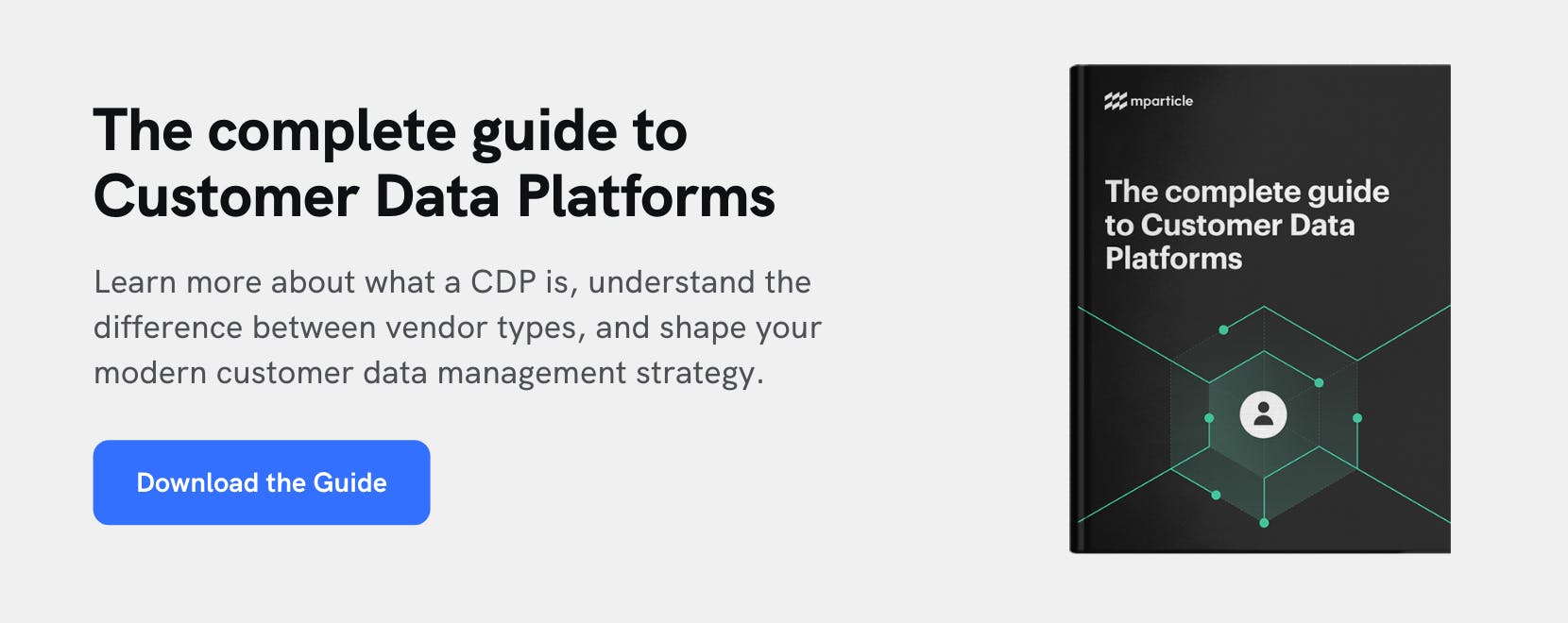The Customer Data Platform vendor landscape
The customer data platform vendor landscape is confusing, but can be segmented along three dimensions: business model, data sources, and customer type. This post explains each one, so you can separate signal from noise and identify the right CDP for your business.

There’s little doubt that customer data platforms (CDPs) are one of the hottest categories in martech right now....and possibly ever. There’s been a flurry of investment, and an influx of vendors embracing the term. But, that’s not to say that all CDPs are built the same. The CDP vendors landscape can be segmented along three dimensions: business model, data sources, and customer types. In this post, we’ll discuss each of these in turn.
But, before looking at the different vendor types, it’s helpful to recap what is and isn’t a customer data platform.
What is a customer data platform?
Gartner defines a customer data platform as a marketing system that “unifies a company’s customer data from marketing and other channels to enable customer modeling and optimize the timing and targeting of messages and offers.”
The CDP Institute’s standard litmus test has three parts. Specifically:
- CDPs are marketer-managed systems. This means a CDP must offer a marketer-friendly, web-based interface, with prebuilt connectors and standard (as well as configurable) process flows.
- CDPs create a persistent, unified customer database, without storage limitations. This means a CDP must store granular transaction and behavior details, consolidate identities at the individual level and connect events and attributes to identities.
- CDPs make the data accessible to other systems via APIs, queries, extracts, or other methods, ideally in real time, so that the data can be used as broadly as possible, well beyond any particular channel marketing or advertising use case.
Gartner’s definition adds the additional requirement that, “at a minimum, CDPs must contain the ability to create and manage rule-based segments,” a clarification we like too.
Business model: Pure-play CDPs versus CDP-as-a-Byproduct
Every direct marketing and analytics use case, regardless of the approach and business goals, requires some level of data management. But, recall that, by the above definition, a CDP is a product, not a function. In other words, a CDP is not just any customer database; it is “packaged software” designed to make data available to other systems.
Pure-play CDPs offer no other products than those that enable other systems to understand and anticipate customer needs more thoroughly than they otherwise would on their own. The pure-play CDP's product strategy, pricing and business culture are built entirely around that singular premise. Treasure Data and mParticle are two examples of pure-play CDPs.
If you are a pure-play CDP, there is no hiding behind a report or tool beloved by a particular subset of users within the marketing department. When your success or failure is judged solely on your ability to provide Clean, Complete, Accessible User-Level Data to other systems, you must be excellent at just that.
That being said, the downside of a pure-play CDP is that, as Gartner notes, “Marketers still need execution tools for the final mile.”
On the other side of the CDP vendor landscape, there are many vendors for whom the CDP is just one among many product offerings (and not the most significant one at that). Their CDP may be productized, but it is was originated as a byproduct of other capabilities. They aim to be both the “hub” and some of the spokes.
Companies that offer CDPs-as-a-byproduct resolve the last-mile problem (at least partially). The problem buyers often run into is that, while these vendors may be excellent at one or two execution skills, they are never best in class at everything. The company still needs to integrate with adjacent—and frequently competing—vendors, which can cause friction on many levels.
Data sources: Instrumentation and integration vs integration-only
All CDPs tout their ability to make data available to multiple consumption points, but if that data does not support the demands of the business, what’s the point? That is why it’s critical to understand exactly how a CDP gets its data.
Most CDPs rely entirely on other systems to generate the data. As much as they may solve the “final mile” execution challenges, they do not address the “first-mile” data collection challenges that many companies today face. The result is poor data quality (“garbage in, garbage out”), high latency, and significant blind spots in the customer journey (particularly when it comes to mobile and connected device data, which often pose the most significant collection hurdles).
In addition to integrating data that already exists in other systems, CDPs vendors like Segment and mParticle also address the “first-mile” instrumentation challenge with native SDKs that provide a standard mechanism for collecting data from the points of origin. These ensure consistency in how tracking works across all devices and screens and allow business users to act on data “from the edges” in real time (or near-real-time) to support moment-based use cases (like sending a messaging to someone who has just entered a geofence).
Customer Focus: Enterprise vs SMB
The third main point of difference among CDP vendors is customer focus.
Large enterprises have vastly different data needs from small-to-medium businesses (SMBs). As much as the end use cases may all sound very similar, what lies beneath the surface can make or break a CDP implementation. CDPs like Tealium and mParticle that focus on working with large companies offer capabilities like:
- Scalability to hundreds of millions of records;
- Enterprise-level security and governance including encryption, data filters, and controls;
- Advanced integration services including processes for performing transformations (changing formats or combining data, for example), validating data sources, and allowing independently-designed data structures to be used together;
- Complex identity resolution including multi-dimensional identity frameworks and third-party identity service integrations;
- Sophisticated data governance providing for risk assessment, control, and compliance as it relates to data quality, security, privacy, and retention; and,
- Inter-operability with diverse systems and use cases including not just other growth software companies but also the major marketing clouds (e.g. Salesforce, Adobe, Oracle) and media platforms (e.g. Google, Facebook).
On the other hand, CDPs that target SMBs work well to manage smaller customer datasets that don’t need a lot of customization to produce results. For them, the enterprise capabilities listed above would be like applying a hammer to a thumbnail.
That being said, SMB-focused CDPs may struggle to scale to higher data volumes and complexity, and more diverse use cases.
Find the right CDP for you
Many buyers focus too much on the immediate use case and not the longer-term data strategy. Before talking to any CDP vendors, our recommendation is to ask yourself some foundational questions:
- Is your data ingestion clean and complete from all points of origin? Is there consistency in how the tracking works across all methods and sources? Can you act on data “from the edges” in real-time (or near-real-time) with your current data collection strategies?
- How messy and idiosyncratic are your data sources? Put another way, how likely or unlikely is it that out-of-the-box data schema and entity resolution approaches will be able to transform all of your data into a consistent customer profile?
- What are all the various components of your stack you wish to integrate to maintain a comprehensive view of customers and address their needs?
- Are you struggling to comply with consumer data privacy best practices? How will you federate customer preferences across all systems?
- What is the pace of change of your business? Is your data architecture set up to support innovation and experimentation already, or do you need a CDP that can help make it so?




